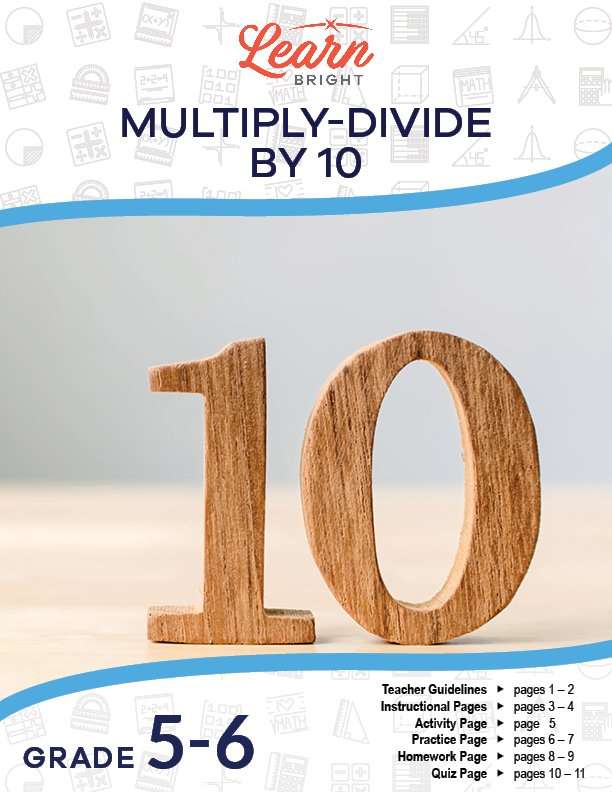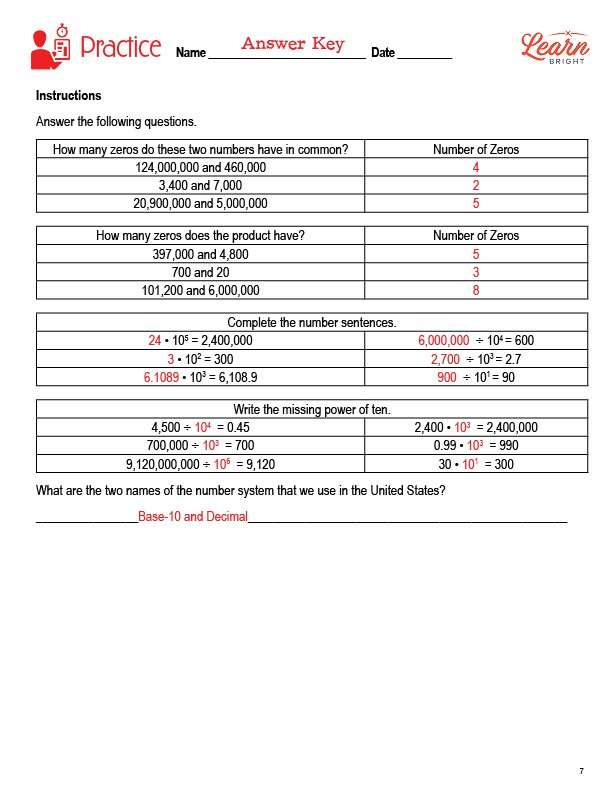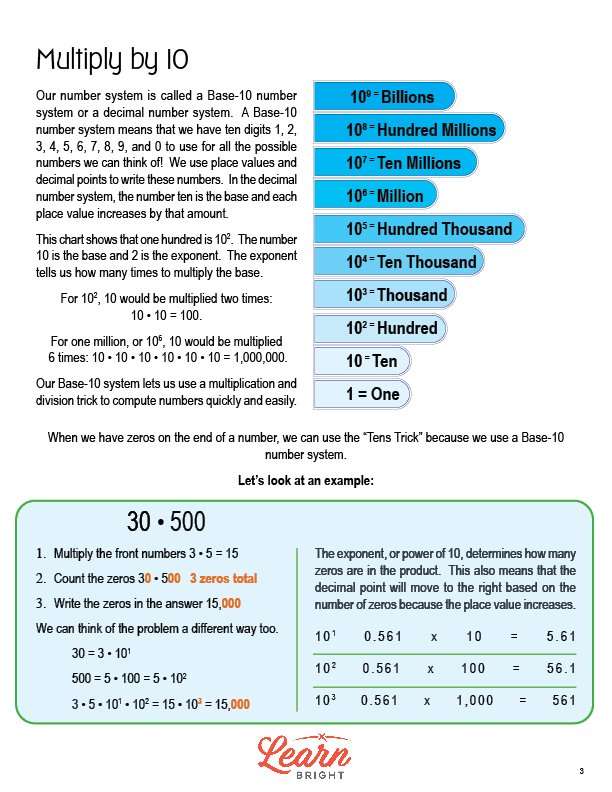Description
What our Multiply and Divide by 10 lesson plan includes
Lesson Objectives and Overview: Multiply and Divide by 10 helps students learn tips and tricks to make it easier for them to solve math problems in their heads. The lesson begins by introducing base-10 and other place value related vocabulary and also explores exponents. At the end of the lesson, students will be able to fluently multiply and divide large numbers using exponents with a base of 10. This lesson is for students in 5th grade and 6th grade.
Classroom Procedure
Every lesson plan provides you with a classroom procedure page that outlines a step-by-step guide to follow. You do not have to follow the guide exactly. The guide helps you organize the lesson and details when to hand out worksheets. It also lists information in the blue box that you might find useful. You will find the lesson objectives, state standards, and number of class sessions the lesson should take to complete in this area. In addition, it describes the supplies you will need as well as what and how you need to prepare beforehand.
Options for Lesson
Included with this lesson is an “Options for Lesson” section that lists a number of suggestions for activities to add to the lesson or substitutions for the ones already in the lesson. One optional addition to this lesson is to have your students use a dice to roll the number of the exponent to solve various in-class problems. If you’d like to get your students moving around the classroom, you can have each student hold a card and match it with their power of ten for a solution. You can also have your students flip a card to determine if they will multiply or divide their two numbers. Finally, if you have more advanced students, you can have them work more with decimal movement and do an exploration using a decimal after the whole number activity.
Teacher Notes
The teacher notes page includes lines that you can use to add your own notes as you’re preparing for this lesson.
MULTIPLY AND DIVIDE BY 10 LESSON PLAN CONTENT PAGES
Multiply by 10
The Multiply and Divide by 10 lesson plan includes two content pages. The number system we use is a Base-10 number system, also sometimes called a decimal number system. Base-10 number systems use ten digits to create all of the numbers: 1, 2, 3, 4, 5, 6, 7, 8, 9, and 0. When writing these numbers, we use place values and decimal points. In decimal number systems, 10 is the base numbers and each place value increases by that amount.
The lesson includes a helpful chart that shows the relationship between different place values. 1 = one, 10 = ten, 10² = 100, 10³ = 1,000, and so on. For the number 100, the number 10 is the base and 2 is the exponent, which tells us how many times to multiply the base. The exponent is 2, so we multiply the base two times: 10 x 10 = 100. For the number one million, or 10⁶, we multiply the base (10) six times: 10 x 10 x 10 x 10 x 10 x 10 = 1,000,000.
Because we use a Base-10 system, we can use a helpful multiplication and division trick to help us compute numbers quickly and easily. When the number we’re dealing with has zeroes on the end, we can use a “Tens Trick” to solve.
Let’s take a look at an example problem that we can use the Tens Trick for: 30 x 500. To solve, we first multiply the front numbers: 3 x 5 = 15. Next, we count the zeroes. In this case, there are three zeroes total, one from 30 and two from 500. Finally, we write the zeroes on the end of the front number: 15,000. That’s it!
We can also think of this problem in a slightly different way—30 = 3 x 10¹ and 500 = 5 x 10², so we can solve using the following equation: 3 x 5 x 10¹ x 10² = 15 x 10³ = 15,000.
The exponent, or power of 10, tells us how many zeroes are in the product. The decimal point moves to the right based on the number of zeroes because the place value is increasing.
Divide by 10
Division is the inverse of multiplication. Therefore, when dividing, instead of adding zeroes at the end of the number you cross out zeroes.
Let’s look at an example: 1800/30. First, we divide the front numbers: 18/3 = 6. Next, we cross out any zeroes that match. In this case, we cross out one zero. Finally, we write the number of zeroes left to get the final answer, which is 60.
MULTIPLY AND DIVIDE BY 10 LESSON PLAN WORKSHEETS
The Multiply and Divide by 10 lesson plan includes four worksheets: an activity worksheet, a practice worksheet, a homework assignment, and a quiz. You can refer to the guide on the classroom procedure page to determine when to hand out each worksheet.
EXPONENT EXPLORATION ACTIVITY WORKSHEET
For the activity worksheet, students will solve multiplication and division problems that include powers of 10. They will then answer questions about the patterns they noticed when multiplying and diving by powers of 10.
ANSWERING QUESTIONS PRACTICE WORKSHEET
The practice worksheet asks students to answer questions related to the lesson material. They will figure out how many zeros two numbers have in common and how many zeroes the products of two numbers have. They will also complete number sentences and write missing powers of ten.
MULTIPLY AND DIVIDE BY 10 HOMEWORK ASSIGNMENT
For the homework assignment, students will answer four questions about the lesson material. They will explain the pattern you can use to find the product when multiplying a whole number by a power of 10 and explain whether this pattern be the same when multiplying a decimal by a power of 10. They will also explain the pattern you can use to find the product when dividing a whole number by a power of 10 and explain whether this pattern be the same when dividing a decimal by a power of 10.
QUIZ
This lesson also includes a quiz that you can use to test students’ understanding of the lesson material. For the quiz, students will solve two division problems and two multiplication problems.
Worksheet Answer Keys
This lesson plan includes answer keys for the practice worksheet, the homework assignment, and the quiz. If you choose to administer the lesson pages to your students via PDF, you will need to save a new file that omits these pages. Otherwise, you can simply print out the applicable pages and keep these as reference for yourself when grading assignments.









